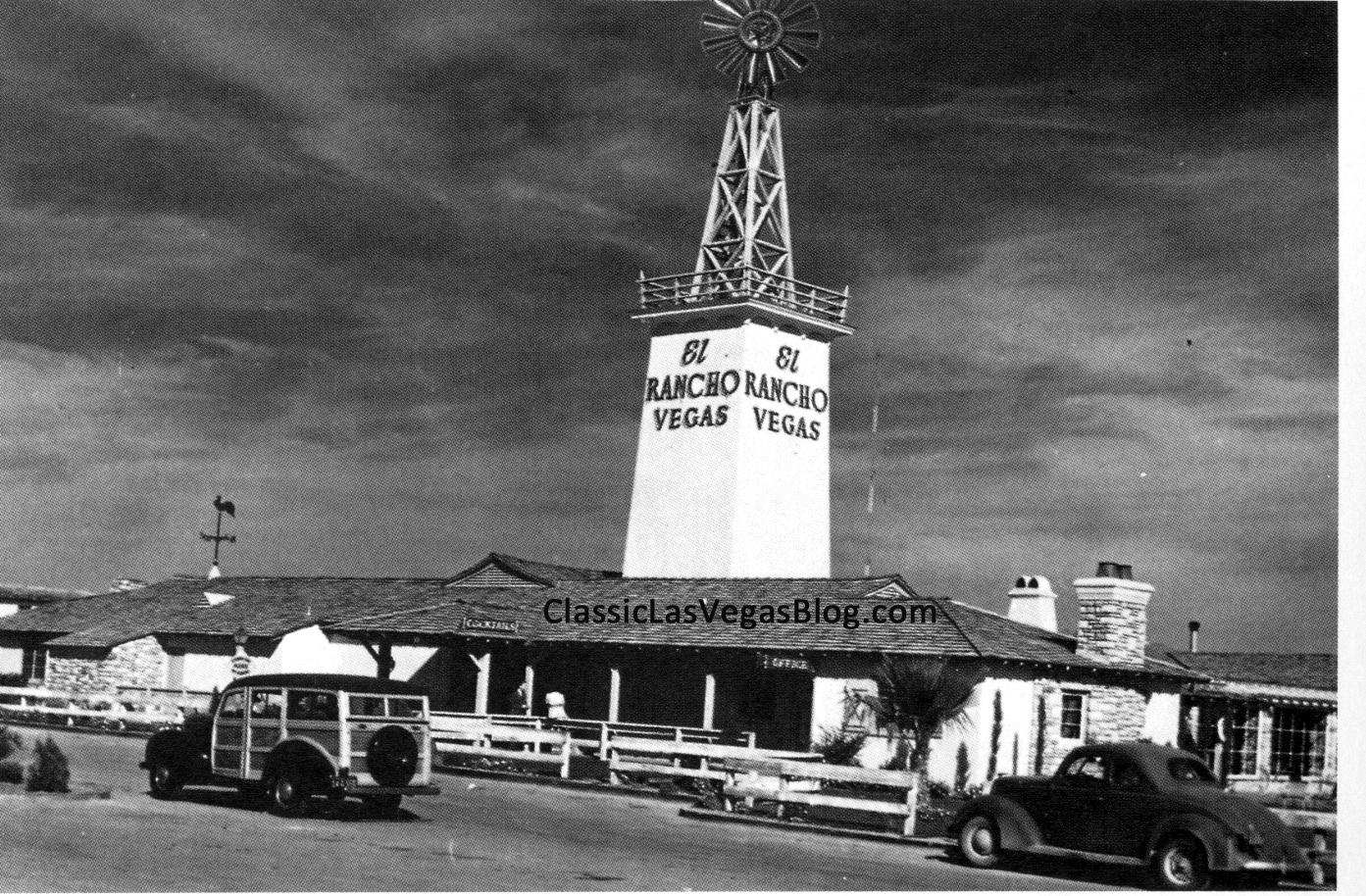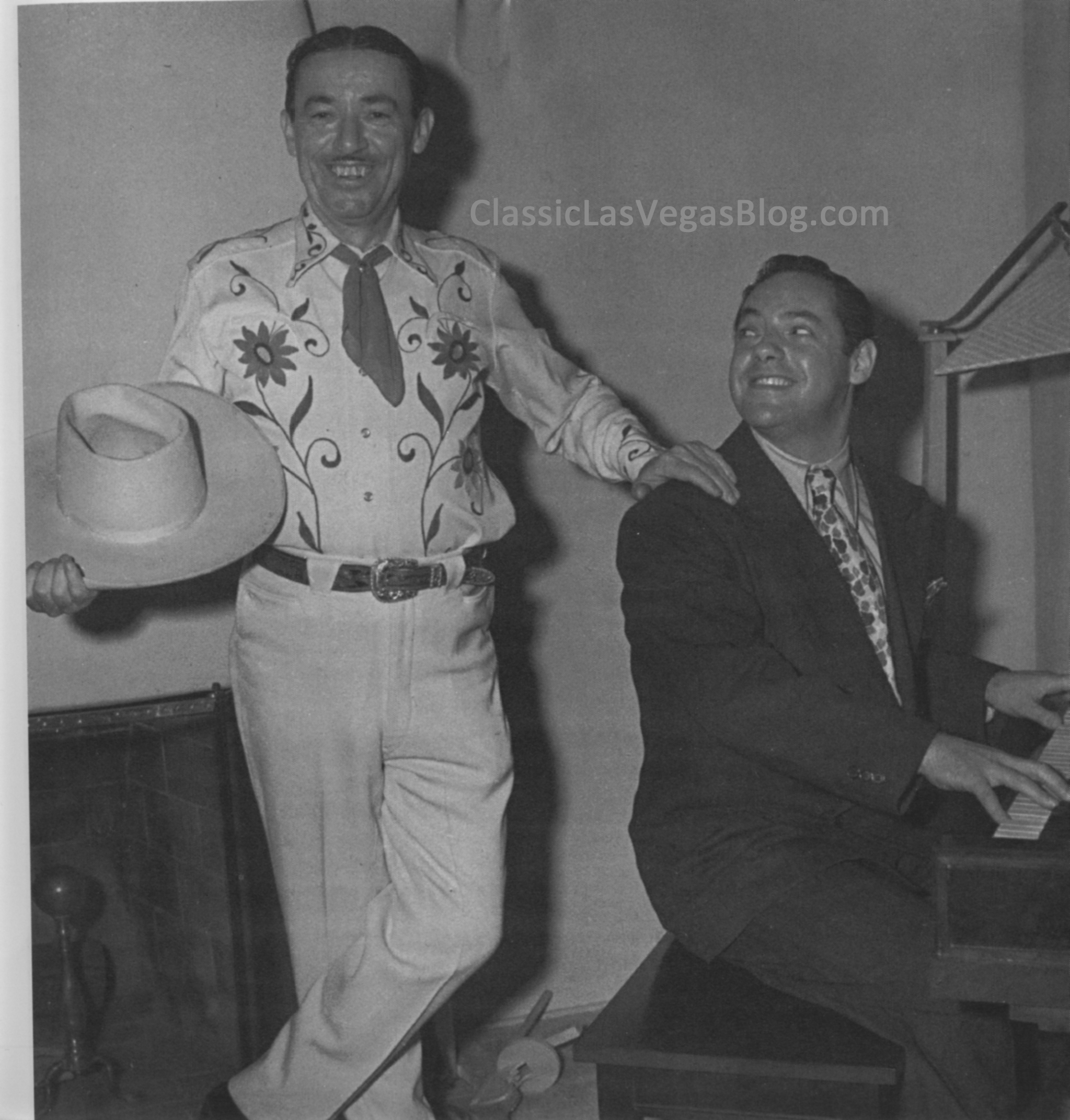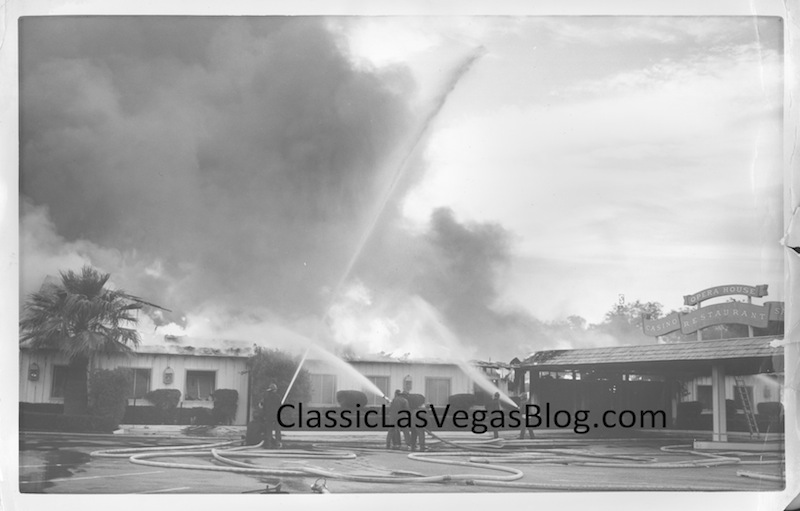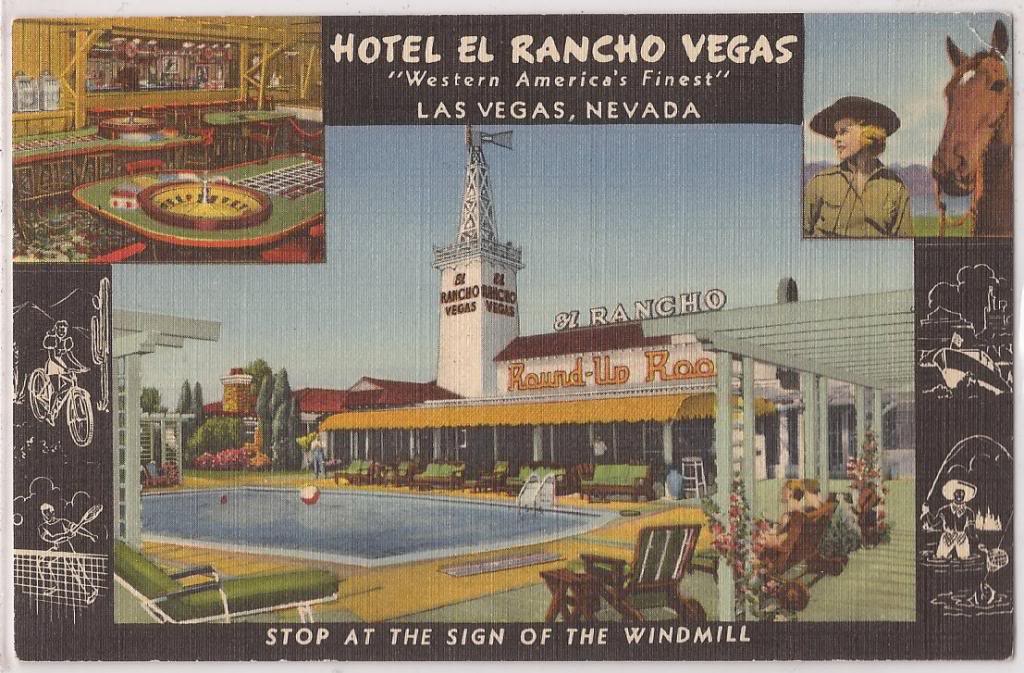Like all good "Lost" Vegas stories, this one begins with a myth:
For decades, the story has been that hotelier Tommy Hull's car broke down on the old LA Highway (Highway 91) near San Francisco Avenue (now Sahara Avenue). It was a hot day with the sun beating down. While waiting for a tow truck, Hull counted the cars that drove by and envisioned a swimming pool that fronted on the highway and would invite weary, sweaty travelers to stop at his hotel.
It's a good story but it's a myth.
Tommy Hull was friends with civic booster extraordinare, Big Jim Cashman. Hull had a chain of El Rancho hotels in California and he operated the Roosevelt Hotel in Hollywood. Cashman worked hard to convince Hull that he should build one of his El Rancho Hotels in Las Vegas. One night over drinks at the Hotel Apache, Hull finally agreed with Cashman. It was 1939 and Las Vegas was a small town. Downtown on Fremont Street (click here for our Brief History of Fremont Street) were a few gambling halls and hotels but nothing on the scale of the El Rancho. Hull priced property in Las Vegas and then turned his eye to the County property on the other side of San Francisco Avenue. The property was owned by Mrs. Jessie Hunt and she thought it was worthless. She had 33 acres that she was all but ready to give away Wanting to get the most for his investment, Hull bought the property (and an additional 33 acres) at a cost of $150 per acre- oh those were the days- on the southwest corner of San Francisco Avenue and Highway 91.
From the beginning, Hull envisioned a ranch style property with a main casino, dining room, a showroom and a lounge. In addition, he envisioned hotel rooms where people could drive up to their rooms, bungalows and a swimming pool amid the sprawling, green landscaped lawns. He knew that after hours of driving from Southern California (in the days before air-conditioning in cars), people would be tired of seeing the desert and the El Rancho would look like an oasis by comparison.
Hull hired famed architect Wayne McAllister (for more info on McAllister click here) of the firm McAllister and McAllister. The first rendering closely matched the finished complex. The neon-lit windmill atop the main building would become its trademark. In those early days, the neon signage could be seen for miles. The buildings were all painted white and the grounds landscaped with green grass, flowers and palm trees.
The El Rancho Vegas
The famed pool was surrounded by chaise lounges and a brightly designed verandah where swimmers could get a cool drink after swimming in the turquoise water. The verandah's canopy was supported by colorful y-shaped beams. The sun arbor, a trellis with white wooden beams, was filled with an explosion of colorful flowers.
The Wagon Wheel Tavern offered old fashioned chuck wagon dinners and the decor was straight out of a Hollywood Western set with wagon wheels and hitching posts. There was the Stage Door Steak House, the Nugget Nell Cocktail Lounge (with entertainment), the Opera House dining room and showroom. The casino was small compared to the 300 seat showroom. Again, the decor was straight out of Hollywood with wagon wheel chandeliers.
The El Rancho Vegas opened on April 3, 1941 and most of Las Vegas, it seems, showed up for the gala opening. Highway 91 was a rough, pot-holed two lane blacktop road in those days so getting there was a bit of hike from downtown not to mention a bumpy ride. Bandleader Garwood Van (who would later own one of the premiere music stores in town, Garwood Van's Musicland) and his Orchestra were hired for 4 weeks and ended up playing for over 13 months. Hull hired a troupe of showgirls and had them dressed in scanty western attire. Van would also serve as liason for Hull and his California office.
Tommy Hull and Garwood Van, right
When World War II broke out, Hull arranged for servicemen at the overcrowded Gunnery School (now Nellis Air Force Base) to stay at the El Rancho. They built an additional 60 units to accomodate the military and the rooms were never empty.
In 1942, Carol Lombard and her mother (along with 20 other passengers) were flying home from a cross country War Bonds Drive. Lombard and her mother were supposed to go by train but Lombard was eager to get home to her husband, movie idol Clark Gable. They had a fight before she left for the tour and she hadn't said good-bye. She never made it back to Los Angeles. The plane crashed into Mt. Potosi. Out in Searchlight at the Walking Box Ranch, Western movie star Rex Bell and his foreman saw the smoke from the crash and loaded their horse trailers and started towards the mountain hoping they could be of help. Bell's wife, silent film star Clara Bow, and their son, Rex, Jr. watched the smoke from the balcony of their ranch house.
Clark Gable, upon receiving the news, rushed to Las Vegas in hopes that Lombard and the others would be found alive. He stayed at the El Rancho Vegas. Reports are that he paced the floor of his bungalow awaiting word. When word came that Ms. Lombard and everyone on board had perished, Gable wired Spencer Tracy. Tracy came at once to help his friend. He, too, stayed at the El Rancho where the two were seen drinking into the night. Once the funeral arrangements were made, Gable and Tracy headed back to Los Angeles.
It was Hull's intention to make his resort self contained. Anything his guests needed, his staff was there to be sure they were accomodated. It was a departure from the thinking of the downtown gambling halls where the focus was on gaming. Hull wanted his guests to feel like they were on vacation and having the time of their lives. That way they would go home and tell their neighbors and friends who would want to vacation at the El Rancho Vegas as well.
The Western motif was extended to the staff. Everyone, it seems, wore western outfits. Hull stopped wearing his customery tuxedo and could be seen greeting and talking to guests in jeans, a western shirt and a ten-gallon hat. Garwood Van had custom embrodiered western suits made. The Orchestra would go out to the airport to greet customers and ensure that they got to the hotel safely. The shops in the main building included a first for Las Vegas, Cole's Travel Agency.
Hull used his Hollywood connections to bring some of the best entertainment of the day to the El Rancho. Over the years, Sophie Tucker. the Last of the Red Hot Mamas and a favorite of Sinatra's, became a mainstay at the El Rancho Vegas. Joe E. Lewis, Peggy Lee, Zero Mostel, Guy Lombardo, Milton Berle, Buddy Hackett, Jackie Gleason, Jimmy Durante, Nat King Cole, Jerry Lewis and Dean Martin, Eartha Kitt, Kay Starr, Sammy Davis Jr., with the Will Mastin Trio, the Williams Brothers with Andy Williams, and the Ritz Brothers all played the showroom at the El Rancho Vegas. It became popular for other entertainers to visit while Sophie Tucker or Joe E. Lewis were in town and join them on stage. Tucker often flew in for impromptu gigs with Lewis. This kept the showroom jumping until dawn.
The Chuckwagon Buffett was born at the El Rancho. Late at night, gamblers would get hungry but they wouldn't want to break away from the tables to go to the dining room for a meal. Hull and Van devised the Chuckwagon Buffett where those busy gambling could grab a quick sandwich and eat while trying their hand with Lady Luck.
The El Rancho was so successful that R.E. Griffiths decided that there was room and clientele enough for two resorts and he built the Hotel Last Frontier, closely following the model that Hull had perfected at the El Rancho Vegas.
Nugget Nell Lounge - the Sam Melchionne Trio
The opening of the Hotel Last Frontier and the Flamingo Hotel spurred new growth on the Las Vegas Strip and Tommy Hull began to feel that perhaps the time had come for him to sell. He lived in Los Angeles and would commute to Las Vegas on a regular basis. After talking with his auditor, he sold the property to Joe Drown, who was an associate of Conrad Hilton's. The property passed through several hands, including Wilbur Clark's, before Maurice Katelman bought the property in 1947. His nephew, Beldon, inherited the property shortly after the sale.
Beldon Katelman expanded the Opera House Theater and the Casino area. He added a French Provincial motif to the bungalows. In 1947, the El Rancho consisted of 22 buildings and 144 rooms (which included the military quarters). By 1960, the property had 69 buildings and 220 rooms.
Paul Newman and Joanne Woodward ushered in the era of Las Vegas celebrity weddings by getting married at the El Rancho Vegas on January 29, 1958. They were not yet superstars and Katelman had to send a memo to the staff outlining what was needed to make the wedding a success. They were married in Katelman's bungalow.
Paul Newman and Joanna Woodward moments after their wedding ceremony
Katelman brought in investors and quickly gained control of the hotel. Under his guidance, the hotel soared to its glory days as an entertainment and resort haven in the desert.
All of that came to end early in the morning of June 17, 1960. A fire broke out in the main building and quickly spread. The call came into the fire station at 4:50 am and three engine companies, two pumpers and the brand new $50,000 airplane crash truck responded to the call. By the time the trucks arrived the main building of the hotel was engulfed in flames. They used over 30,000 gallons of water trying to fight the fire. The fire eventually toppled the famed neon landmark sign, the Windmill.
The fire had begun in the back of the Opera House Theater but it had gotten hot and out of control very quickly. The evacuation of the theater, the casino and the shops was very orderly.
The next morning, Katelman displayed a mass of metal that had been silver dollars. Over $400,000 in silver dollars and other coins were lost during the fire. Sheriff Butch Leypoldt and his under-sheriff Lloyd Bell had pried open the vault with a crowbar and were responsible for saving boxes of money.
The smoke from the fire was so thick that Pearl Bailey, Mimi Hines and her husband, Phil Ford, jumped into Bailey's car and backed into a tree trying to leave the hotel. Betty Grable and her husband, Harry James had been performing a late show in the Opera House Theater and lost over $10,000 in costumes. Grable was seen crying openly while watching the fire. Comedian Red Skelton was there taking home movies of the tragic fire.
Red Skelton films the fire.
In less than an hour, the first resort that had given birth to the Las Vegas Strip, was gone.
Fire rages at the El Rancho Vegas
Firefighters fight the blaze
Beldon Katelman watches the El Rancho Vegas burn
Burned building at the El Rancho Vegas
Katelman promised to rebuild an ever bigger and grander El Rancho Vegas but that never happened. It became a motel operation that only served to remind the old-timers of what a wonderful place it had been. Katelman put the property up for sale in the late 1960s. Howard Hughes bought the property for $7.5 million dollars. Hughes put down 2.7 million in earnest money and the rest in an escrow account. Before the deal could be finalized, Katelman demanded more money. Hughes balked and the two went to court for over two years.
Finally, they settled out of court with Hughes paying Katelman an extra million dollars. Instead of doing anything with the property, Hughes just let the remaining buildings and bungalows bake in the desert sun. Some of the buildings were trucked out to Henderson and became part of the "Old Vegas" theme park, which in turn became Westworld and is now a housing development. When I was a teenager, you could still see some of the bungalows on the property and follow the driveways around to long gone destinations. One morning, we woke up and the bungalows had been moved off the property and the remaining buildings were demolished.
Where are the bungalows today? One is privately owned and was relocated to Pahrump, one is on E. Charleston Blvd near the Ralph Jones Display Company, another is an Antique Store also on East Charleston.
In the 1980s, the Hughes Corporation sold the property to the Bennett Family, owners of the Sahara Hotel. They, like Hughes before them, did nothing with the property. In 2007, the Bennett Family sold the property to a developer.
What will be built on the land that once housed the first dude ranch resort on the Las Vegas Strip? Only time will tell. It is still a vacant piece of land.
Please note: The El Rancho Vegas has no connection other than a similar name to the El Rancho which was built on the old Thunderbird property back in the 1980s.
The El Rancho Vegas had three well-known signs: the neon windmill atop the main building,
The El Rancho Vegas in all its neon splendor
the chasing, chaser bulb arrow sign that sat across the highway from the resort and pointed towards the main building, and in later years, a small neon sign on Sahara Avenue that pointed towards the motel rooms.
Chaser bulb sign
The Alec Baldwin/Kim Basinger film The Marrying Man offers a great recreation of the El Rancho Vegas Hotel as the setting for the film. The sets were built out in Lancaster, California.
El Rancho Vegas postcard
What do you remember of the El Rancho Vegas? Hit the comments and share your memories with us!
Images courtesy of Bo Boisvert, Don English, Classic Las Vegas and the As We Knew It Archive.















